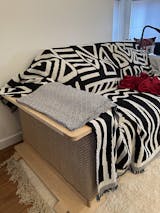If your cat keeps scratching your furniture, you’re not alone. Scratching is one of the most common feline behaviors and one of the most misunderstood.
Here’s how to train your cat to stop scratching where they shouldn’t, and encourage them to scratch where they should.
Step 1: Choose the Right Scratching Surface
Every cat has different scratching preferences. Since some cats prefer vertical posts while others favor flat mats, choosing the right scratching surface is the crucial first step to success.
Here’s what to try:
- Sisal: Strong, coarse, and bark-like, perfect for cats that dig in deeply.
- Cardboard: Great for cats who love texture and noise when they scratch.
-
Carpet or fabric: For cats who prefer a softer grip.
A good scratching post must be tall, sturdy, and stable. Cats simply won't use a wobbly one, because they want a solid surface for a proper stretch.
Step 2: Place It Where Your Cat Already Scratches
If your cat loves your couch arm, place a scratching post right next to it. Cats don’t go out of their way to find new scratching spots — they stick to familiar zones.
Once your cat starts using the post, slowly move it to a more convenient place.
3 Quick tips:
- Keep one in each main living area.
- Place a horizontal scratcher near where your cat naps.
-
For multi-cat homes, have at least one post per cat, plus one extra.
Step 3: Make It Appealing
Encourage your cat to explore their new cat scratcher with positive reinforcement:
- Sprinkle a bit of catnip or use a natural catnip spray.
- Dangle a toy or a feather wand around it during playtime.
-
Reward your cat right after they use it with a treat or praise.
Cats learn best through positive experiences, never punishment. A few consistent rewards can quickly shift their focus from the couch to the post.
Step 4: Protect Furniture During Training
While your cat learns, use natural deterrents to keep them away from furniture:
-
Cover common scratching spots with double-sided tape or vinyl protectors.
-
Spray light citrus scents (cats usually dislike them).
-
Move tempting items, like blankets or cushions, temporarily.
If you’re using a protector like Cat-e-Corner, choose the correct riser so that the table lies flush with your sofa arm and ensure the unit’s natural-wood finish complements your décor. This means your cat uses the built-in sisal panel instead of the sofa, while the addition doesn’t clash with your interior.
Step 5: Keep Stress Low and Enrichment High
Scratching often increases with stress or boredom. Give your cat more ways to burn energy and feel secure:
- Schedule daily playtime with interactive toys.
- Provide cat trees or window perches for climbing.
-
Offer extra cuddles and spend more time playing with your cat, especially if they seem anxious.
Keep in mind that when cats are content and mentally active, they scratch less destructively.
Step 6: Maintain Healthy Claws
A huge difference comes from regular nail trims, cutting down on damage while also making cats more comfortable when scratching. For anyone unsure how to do this, your vet or groomer can easily provide a quick demo.
You can also use soft claw caps temporarily while your cat adjusts to new scratching routines.
What If Your Cat Still Scratches the Furniture?
Don’t give up! Some cats just need more time or a different texture. Try experimenting with:
- The height and angle of cat scratchers.
- Different materials (natural sisal, cardboard, or carpet).
-
A post right at the problem spot before moving it later.
If scratching continues despite these efforts, it might be linked to stress, anxiety, or skin discomfort. A vet visit can rule out any health issues and help you find an adapted solution.
FAQs About Training Cats to Scratch Properly
Q. How long does it take to train a cat to use a scratcher?
A. Usually, a few weeks, depending on consistency and your cat’s personality.
Q. Do kittens need scratching posts, too?
A. Absolutely! Starting early helps them form good habits that last a lifetime.
Q. What if my cat ignores the scratcher?
A. Try moving it or changing the material; sisal often works best.
Q. Is trimming claws necessary?
A. Yes. Regular trims protect both your cat and your furniture.
Q. Can declawing fix scratching?
A. No. Declawing is painful and permanently affects a cat’s movement. Redirection is a humane and effective alternative.










